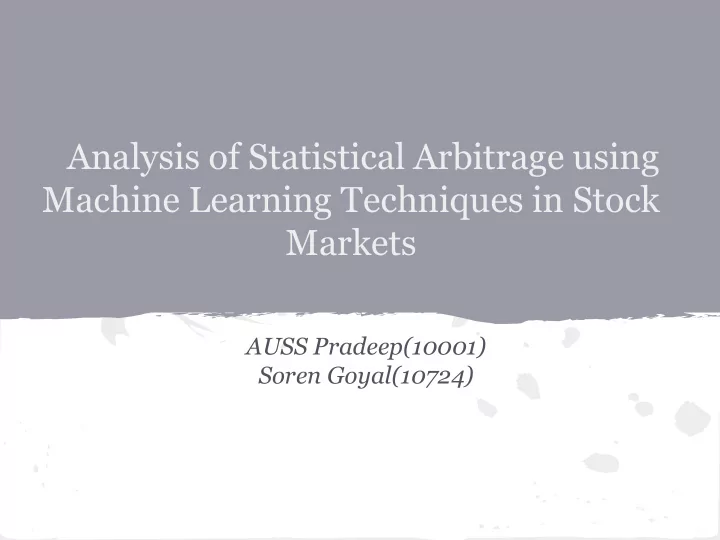

Analysis of Statistical Arbitrage using Machine Learning Techniques in Stock Markets AUSS Pradeep(10001) Soren Goyal(10724)
What is Arbitrage? Rs Rs 100 200 Kanpur New Delhi • Buy the Doll in Kanpur and sell it in New Delhi
Reason for Arbitrage • Market Inefficiencies - In real world market information cannot be communicated without a time lag. This leads to different pricing of the same product in different markets.
Arbitrage in Stock Market • The stock may be mispriced
The Project Predicting the price of the Stock based on historical Data. Virtual Stock Target Stock
Virtual Stock Method • Create a virtual stock which mirrors the behavior of the Target stock. Select the Stocks which are related to the Target Stock Target Stock – TV Today Group, Index Stocks – members of CNX Media Index ( 15 stocks) Create a Linear super position of the stock prices of member stocks Linear Regression, PCA + Regression Compare the prices of the target stock with the virtual Stock To decide when to But or Sell
Stocks used to create the “Virtual Stock” Target Stock
• Using regression we calculate the coefficient θ i
• The index created will represent the actual price of the Target Stock. • If the price of the Target price is greater or lesser than the index, then the Stock is mispriced i.e, an Arbitrage has occurred.
Target Stock Method • The data of the Target Stock is used to alone to generate predictions • Method use – Fitting using TDNN
What is TDNN? Source : Comparative Study of Stock Trend Prediction Using Time Delay, Recurrent and Probabilistic Neural Networks, 1998
Can a neural network be used to profit from the stock market?
Model of Neural Network • 10 hidden layers with 10 neurons per layer.
• The data chosen varied in length, and because it was thought that these factors might affect the types of patterns contained in them and hence the performance of a learning machine. • The length of each segment was either 100 and 900 weeks
Results
• It was thought that a longer segment might simply provide more training data, or • Conversely that a shorter segment might contain patterns more relevant to the near future movement of the stock.
• The raw closing price data was calculated at the end of a week. For example,for the training phase 75% of data was used, 15% for validation and 15% for testing.
• The trading strategy learned by the networks was as follows: If at the end of a sequence of 50 daily closing prices, the price will go up by 2% or more over the next 20 days, buy it. This strategy was chosen as a balance between two opposing forces. • On one hand, it is easier to predict the movement of a time series a short period into the future.
• These trends are promising, and would seem to indicate that by training a machine on the proper amount of data and by using the right type of learning machine, one might be able to beat the performance of an individual stock, on average
Status • Out of the 3 mentioned methods, we have successfully implemented the method involving TDNN. • Beyond this we will compare the performance of the methods on the same stock. • Further, we will like to include “Recurrent and Probabilistic Neural Networks”
References • [1] “Machine Learning in Statistical Arbitrage” published by Xing Fu, Avinash Patra. (December,2009) • [2] “A Statistical Arbitrage Strategy” a master thesis project by Kun Zhu, Royal Institute of Technology, Stockholm, Sweden. (2005) • [3]Article on Arbitrage on Wikipedia http://en.wikipedia.org/wiki/Arbitrage • [4] “Statistical arbitrage and tests of market efficiency” published by S.Horgan, R.Jarrow, and M. Warachka (2002). • [ 5] “An Improved test for Statistical arbitrage” published by Robert Jarrow, Melvyn Teo, Yiu Kuen Tse, Mitch Warachka (2011). • [ 6] “Statistical Arbitrage Stock Trading using Time Delay Neural Networks” a Machine learning final year project by Chris Pennock (Fall 2004).
Recommend
More recommend